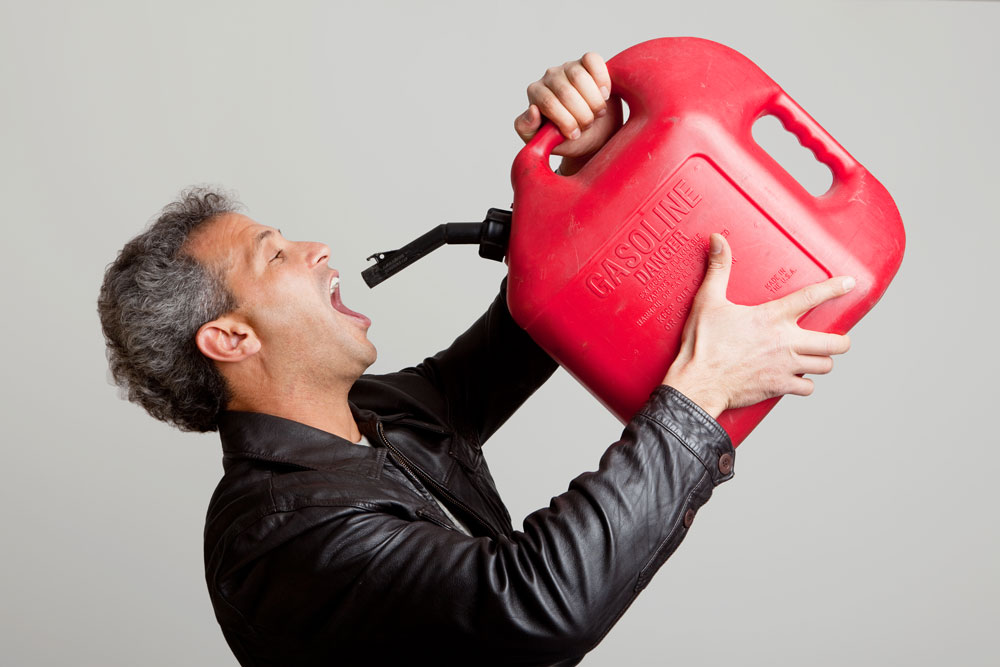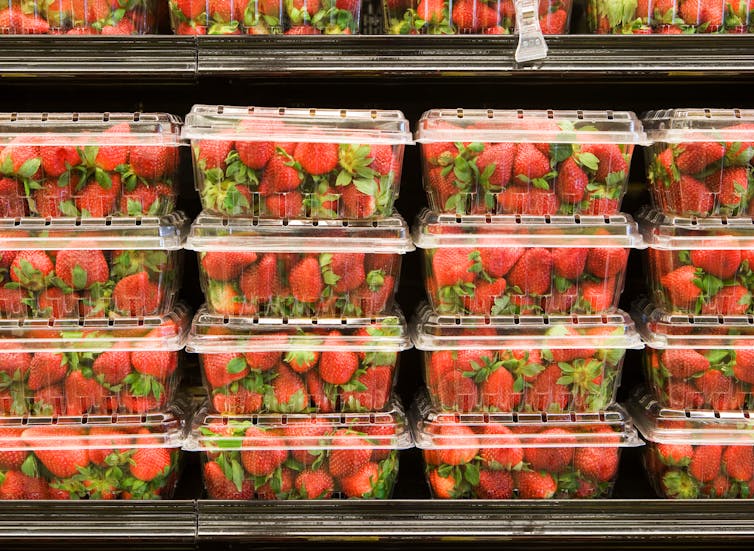
By Veronika Dolar
The price of oil has been spiking in recent weeks in response to concerns that the war in Ukraine will significantly reduce supply. But what happens in oil markets never stays in oil markets.
The price of U.S. crude oil jumped to a 13-year high of US$130 of on March 6, 2022. It has come down but has been trading above $110 since March 17. That’s over 60% higher than it was in mid-December, before fears of a Russian invasion began to mount.
Of course, this has pushed up the cost of gasoline, which hit an average of $4.32 per gallon in the U.S. on March 14. But it’s less well understood how rising energy prices leak into the prices consumers pay for toys, electronics, food and almost every other product you could think of.
Energy is becoming one of the main causes of inflation, by which I mean a sustained, generalized increase in the prices of goods and services in an economy. The latest data shows prices are rising at an annualized pace of 7.9%, the highest in 40 years.
In my economics classes, I like to joke to my students that we eat petroleum. Students have a hard time imagining drinking crude oil or gasoline, but in fact it’s both figuratively and almost literally true – and I’m not even referring to how humans ingest about a credit card’s worth of oil-based plastic every week.
Let me explain.
Planes, packages and polyester
Oil prices affect the prices of other goods and services in a few significant ways.
The most obvious is that petroleum powers the vast majority of cars, planes and other vehicles that move stuff around. About 71% of the 6.6 billion barrels of petroleum the U.S. consumed in 2020 was used for various types of fuels, such as gas, diesel and jet fuel.
This pushes up transportation costs and makes shipping everything from refrigerator components to everyday items like toothpaste more expensive. Businesses can choose to absorb the cost – for example, if their market is highly competitive – but usually pass it on to customers.
But oil is also a key ingredient in much of the stuff people buy, both in the packaging and in the products themselves, especially food. That’s where most of the other 29% of the oil Americans use comes in.
Petrochemicals derived from petroleum are used to manufacture clothes, computers and more. For example, the quantity of oil-based polyester in clothing has doubled since 2000. Over half of all fibers produced around the world are now made from petroleum, requiring over 1% of all oil consumed.
In addition, the cosmetic industry is heavily dependent on petroleum since items such as hand cream, shampoo and most makeup are made out of petrochemicals. And like with many products, all those creams and beauty liquids are put in single-use plastic containers made from oil.
Similarly, the vast majority of toys produced today are made out of plastic.
Crude in our cookies

AP Photo/John David Mercer
The food industry is especially sensitive to the price of energy, more so than any other sector because petroleum is such a key component of its supply chain at every step of the way, from planting and harvesting through processing and packaging.
Interestingly, the biggest usage of petroleum in industrial farming is not transportation or fueling machinery but rather the use of fertilizers. Vast amounts of oil and natural gas go into fertilizers and pesticides that are used to produce and protect grains, vegetables and fruits.
That’s one of the reasons it takes 283 gallons of oil to raise one 1,250-pound steer. And it’s why even a loaf of bread requires an unusually high amount of energy.
Oil is also an ingredient in the food we consume. The main food product that comes from petroleum is known as mineral oil. It’s commonly used to make foods last longer because petroleum doesn’t go rancid. Packaged baked goods like cookies and pizza often contain mineral oil as a way of preserving their shelf life.
Petrochemicals are also used to make food dyes, which can be found in cereals and candy.
Paraffin wax, a colorless or white wax made from petroleum, is used in the production of some chocolates and sprayed onto fruits to slow down spoilage and give them a glossy finish. It also helps chocolates stay solid at room temperature.
And plastic is a vital part of food packaging because it is relatively cheap, durable and lightweight, it provides protection and is sanitary.

nycshooter/E+ via Getty Images
Oil inflation and the Fed
The importance of oil to the U.S. economy has been a big concern since the oil crisis of 1973, when prices spiked, prompting calls to conserve energy.
Since then, the amount of oil consumed for every dollar of economic output has declined about 40%. In 1973, for example, it took just under one barrel of oil to produce $1,000 worth of economic output. Today, it takes less than half a barrel. That’s the good news.
The bad is that, because the U.S. economy is now 18 times bigger than it was in 1973, it requires a lot more oil to function.
That’s why the surging price of oil is now the main driver of inflation – and why the Federal Reserve is preparing for some big increases in interest rates to fight it.
[Get the best of The Conversation, every weekend. Sign up for our weekly newsletter.]
Veronika Dolar, Assistant Professor of Economics, SUNY Old Westbury
This article is republished from The Conversation under a Creative Commons license. Read the original article.
![]()
Veronika Dolar is Assistant Professor of Economics at SUNY Old Westbury.




























Jimbo99 says
And this is why EV’s are a fantasy with as many human beings are on this planet. Tesla was built on relatively affordable oil. Elon Musk even knows that. His Aerospace program, those rockets don’t lift off on batteries. Any scientist telling us that he grid is going to replace fossil fuel is a fool of the highest order. The one’s touting electric, they’re on the gravy train with their High School science projects. The entire plan behind EV’s, that gets traffic off the roads because who can afford a 2nd mortgage for a car payment on a $ 50-130K EV. Even economy gasoline automobiles doubled in price when the Bush-Obama auto industry bailouts happened. This is like rebuilding dunes on the coast, the next storm wipes out that foolishness, & it’s not even a hurricane it’s a winter Nor’easter that washes the dunes back into the Atlantic Ocean. All this is happening, it’s just a matter of who banks on the rebuild & when they get out of that game as padding their retirements.
Prices are soaring because humans just don’t when to stop making more humans. And you want an instant surge of people that haven’t been paying into the USA system, open the borders and start airlifting illegal & refugee families throughout the USA. Works great for Biden, he’ll let anyone vote, not so well for anyone that lives where the instant population growth occurs. I have empathy for anyone that wants a better life. This is just spreading the misery though. Not all immigrants are bad, I get that, tell that to the family of 4 that have to carry on in life without their father. That’s 65 miles from Flagler county, connect the dots, how many prostitutes & criminals from Jacksonville end up in Flagler county even if it’s just for a evening of house calls & home invasions, drug deals or whatever else we’re having to increase FCSO manpower for. For every decent citizen that arrives, is that worth the increase in crime rate ? Wait until they start hanging out at the splash pad in the park or over by the schools at those recreational sports complexes on Belle Terre or even the downtown park area in Bunnell ? BPD turned over & hired FCSO for that level of crime. So now the rest of Palm Coast & Flagler county is paying for Bunnell’s most heinous crime & law enforcement services in the Mondex. These are the costs of Biden-Harris, continuing to send billions to the corrupt governments/nations that are the source of this surge of humanity.
https://www.cnet.com/science/elon-musk-calls-for-increased-nuclear-power-oil-and-gas-production/
https://www.news4jax.com/i-team/2021/11/16/i-team-documents-show-78-flights-carrying-migrants-landed-in-jacksonville-over-last-6-months/
https://www.news4jax.com/news/local/2021/11/04/gov-desantis-draws-attention-to-jacksonville-murder-case-involving-migrant/